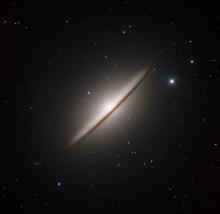Listen to today's episode of StarDate on the web the same day it airs in high-quality streaming audio without any extra ads or announcements. Choose a $8 one-month pass, or listen every day for a year for just $30.
You are here
The Sunflower
If you’re an astronomer who studies faint, wispy objects like spiral galaxies, then this is your time to shine. The Moon was new yesterday, so it doesn’t fill the sky with its glow. With the pesky moonlight out of the way, those faint galaxies will shine at their best.
One example is M63, a spiral galaxy in the constellation Canes Venatici. It’s in the eastern sky in early evening, and soars high overhead later on. It’s also known as the Sunflower Galaxy for its beautiful shape and color. It’s bright, so it’s visible through just about any telescope. But the moonless night makes it easier to see some of the details.
In some ways, M63 resembles our own galaxy, the Milky Way. It’s about the same size and mass. And it appears to have a central black hole, although if it does it’s a lot bigger than the Milky Way’s.
Also like the Milky Way, the outer edge of the galaxy’s disk is bent, and probably for the same reason: the gravitational pull of companion galaxies. In the case of M63, the companions appear to pull out long, faint ribbons of stars that show up in long-exposure photographs.
And there’s one more similarity: Both galaxies are surrounded by haloes of dark matter. It far outweighs the bright matter, so it exerts a strong pull on the galaxy’s stars and gas clouds. But the dark matter produces no energy of its own, so there’s no way to see it — no matter how dark the skies are.
Script by Damond Benningfield






